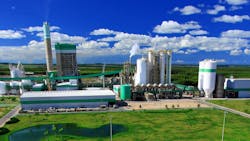4 ways AI technology can move your asset performance management strategy beyond predictive maintenance
The traditional asset performance management (APM) market is focused on predictive analytics for predicting equipment failures. Whereas conventional maintenance software primarily tracks time-based maintenance practices, newer technologies are making it easier to move away from calendar- and condition-based maintenance as needed. These new technologies incorporate artificial intelligence (AI) that use machine learning (ML) algorithms to predict issues with equipment before they become failures.
Aspen Technology has spent the last 42 years helping customers design, operate and maintain their assets and is now helping manufacturers employ AI to advance prescriptive maintenance. In this article, three AspenTech experts discuss how new technologies are changing industrial APM strategies, and specifically how one manufacturer strategically deployed AI/ML technology on three machines to address process-induced failures on those assets.
4 ways that advanced APM is changing
Technology is pointless if it doesn’t drive business value. For AspenTech, APM looks more holistically at the system of assets together and considers all the predictive maintenance strategies that can drive business value.
“What’s the business value I’m driving? Am I improving my meantime to repair? Am I reducing my inventory costs and reducing my overall maintenance costs,” asks Don Busiek, senior vice president and APM general manager at Aspen Technology. “When we talk about implementing software, it’s really about what’s the business value.”
A system of assets together tells more than any single asset can individually. The next level of APM looks beyond predicting equipment failure to the overall manufacturing process. Technology helps APM strategy combine asset condition and process parameters. How does the manufacturing process affect product quality? How does that change under different variables?
“There can be process induced failure in one asset because of an upstream asset or a downstream asset, and what exactly this particular asset is doing in the process actually determines how fast the asset is degrading,” says Nithiya Parameswaran, vice president of product management at AspenTech.
The changing workforce needs technology to strengthen skills and bridge the generation gap. Every industry is challenged with finding skilled workers, and the generational clash of workers and knowledge presents challenges and opportunities for technology. New software needs to capture the older historical knowledge in a way that works for the current workforce and also appeals to a younger generation that’s familiar with technology.
“Overall there’s arguably less maintenance and reliability workers today in a plant than there was 30 or 40 years ago, so how do we make their lives easier with technology?” asks Busiek.
AI/ML hold great potential for PdM, but advanced analytics are not a solution for everything. AI and ML are powerful tools that can have profound impacts on production, but should be used when appropriate, and other technologies may still provide adequate and cheaper results. Aspen Tech works with plants to determine where tools like AI and ML fit, and where a more traditional method would be better.
“That could be first principles analytics. That can be rules-based analytics. That can be conditioned-based analytics,” says Busiek. “Using machine learning to try to do predictive analytics might not always be the best practice, and it should only be used when it directly drives business value.” A more traditional predictive maintenance strategy can still drive better value, including:
- Time-based maintenance: Routine tasks are performed on a piece of equipment at regular intervals.
- First principles analytics: Physics-based calculations governed by engineering principles dictate early modeling methodologies that mathematically capture process knowledge and domain expertise.
- Rules-based analytics: This is a simpler monitoring technique wherein alerts are triggered when a data point goes out of prescribed range. For example, an alert is triggered if reactor inlet temperature exceeds 350 °F.
- Condition-based analytics: This strategy is based on monitoring the actual condition of an equipment using sensors and measurements. Maintenance is performed only when certain key indicators are underperforming. For example, scheduling maintenance when vibration exceeds predefined thresholds.
Case study: How a pulp and paper facility leveraged AI/ML on three critical assets
Veracel Cellulose, S.A., based in Bahia, Brazil, is an agro-industrial company. It produces an average of 1.1 million tons of pulp each year, integrating forest, industrial and logistics operations. The company also works to restore the Atlantic rainforest in Bahia.
The pulp and paper manufacturer was experiencing production losses from unplanned downtime due to equipment failure, coupled with economic pressures facing the pulp and paper industry, which were changing rapidly due to changing consumer demands and the pandemic. While demand for traditional paper products, such as copy paper, has declined, increased demand for sustainable paper packaging as an alternative to plastics has been accelerated by COVID-19.
Traditional maintenance practices were not enough to combat downtime, and Veracel needed to improve asset performance across the board. The change in production and increased demand needed assets that could run longer and more efficiently. In response, Veracel partnered with AspenTech to detect asset failures using artificial intelligence and machine learning technology.
Calendar-based preventive maintenance practices at Veracel had led to a one channel approach, which meant fixing assets once they were broken. AspenTech’s APM solution brought more collaboration between departments (operations and maintenance) and introduced analytics to understand the assets collaboratively as a system. “If you look at an asset as a siloed entity, you can only do so much,” says Nithiya Parameswaran, vice president of product management at AspenTech.
Sometimes process induced failure happens in an asset because of a downstream or upstream asset. How the particular asset is performing in the process will determine how fast that asset degrades. “That’s where AI/ML technology comes in,” Parameswaran adds, “when you have those sensor values, not just from the asset, but also from a process perspective, in terms of flow and temperature and not just vibration of the asset.” With the incorporation of process parameter data, the algorithms start to predict failures in advance by identifying signatures or patterns in the combined asset and process data.
For Veracel, an upstream liquid ring seal was veering out, so flow fluctuations in the downstream vacuum pump were detected, which could have been attributed to the asset without consideration of process data. Likewise, if the facility didn’t fix that seal, it would slowly get bigger and eventually induce cavitation in the pump, which would eventually cause the pump or bearings to fail. What started out as a process failure would become an asset failure over time, and AspenTech helped Veracel to use AI/ML technology to see those patterns before they led to asset failure.
To start, Veracel focused on AI/ML deployment on three pieces of equipment—a vacuum pump, primary screening equipment, and a recovery boiler fan. The facility was monitoring its production losses quite well, says Pratibha Pillalamarri, senior product marketing manager at AspenTech. “They knew exactly which assets were critical, and that’s where we started,” she adds. Veracel had years of data from sensors and its enterprise asset management (EAM) system in order to identify failure points and rank asset criticality.
The Veracel maintenance team had addressed multiple high current and vibration events on the vacuum pumps prior to failure, yet the cause of failure was unknown. Aspen’s Mtell software detected the event signature 32 days prior to failure and identified the issues related to the liquid ring seal. With advanced notice, inspection and process parameter adjustment could avoid equipment damage and downtime.
AspenTech also focused on Veracel’s primary screening equipment, which is involved in a critical step in cellulose production, removing impurities from the pulp. Maintenance crews could detect a sudden increase in vibration, which would eventually lead to shaft breakdown. “It was nothing that they could fix ahead of time because these are all late-stage detectors. Once you start hearing your equipment, you’re already down the path of degradation,” Pillalamarri says.
With data upstream and downstream of the asset, Aspen Mtell software identified failure signatures 47 days in advance. “We were able to give them advance notice that something is happening in that piece of equipment by analyzing the patterns that led to a similar failure in the past,” she adds. That gave Veracel maintenance crews enough time to fix those equipment issues before they became failures.
The third asset in Veracel’s initial deployment was a recovery boiler fan that was part of the auxiliary power production unit. It’s common for pump and paper producers with massive plants to have their own power generation facility on-site. Wood processing requires massive amounts of power, heat, and steam—920 GWh of power, steam and heat is generated on-site in an auxiliary boiler by burning biomass from the pulp production, which is otherwise discarded as waste.
Veracel also burns black liquor, a byproduct, in the recovery boiler to generate additional power and heat. The power produced is used not only by the facility, but also the surrounding community and represents Veracel’s commitment to lowering its greenhouse gas emissions. Advanced data analysis revealed early warnings of potential high vibration events in the recovery fan boiler 59 days in advance of a typical failure event.
Since the initial deployment in 2020, Veracel has extended monitoring to 12 assets in 2022, including additional pumps, filters, screen equipment and drum washers, with plans to scale across 20 assets in the future.
About the Author

Anna Townshend
managing editor
Anna Townshend has been a journalist and editor for almost 20 years. She joined Control Design and Plant Services as managing editor in June 2020. Previously, for more than 10 years, she was the editor of Marina Dock Age and International Dredging Review. In addition to writing and editing thousands of articles in her career, she has been an active speaker on industry panels and presentations, as well as host for the Tool Belt and Control Intelligence podcasts. Email her at [email protected].
